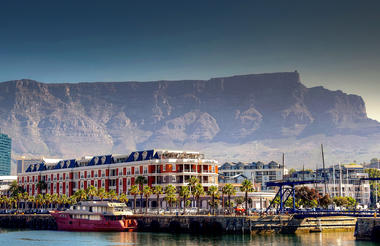Discover Windhoek, the vibrant capital of Namibia nestled in Central Namibia, where history and modernity blend seamlessly! As the heart of the nation, Windhoek is more than just a city; it's a lively hub of culture and activity. With its international airport and a wealth of dining, shopping, and entertainment options, this cosmopolitan city is the perfect gateway to the wonders of Namibia.
Steeped in history, Windhoek's colonial past is evident in its charming German eateries and shops, and the continued use of the German language. The city's architecture is a fascinating mix of old and new. Stroll through the streets to marvel at the Alte Feste, a historic fort that stands as a testament to the city’s past. Visit the 1896 Christuskirche (Christ Church), an iconic symbol of Windhoek’s German heritage. And don't miss the Supreme Court, a striking example of modern architectural design.
Today, Windhoek is a clean, safe, and well-organized city that offers a dynamic urban experience while retaining its unique historical character. Whether you're exploring its historic landmarks or enjoying its contemporary attractions, Windhoek promises a memorable experience in Namibia’s bustling capital.
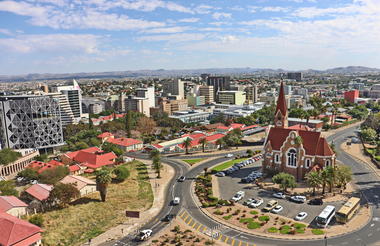

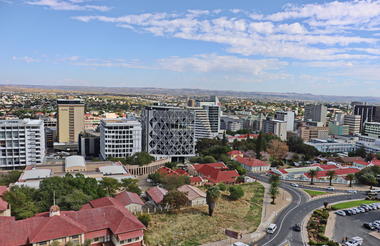
Welcome to Sossusvlei, an extraordinary destination in Namibia's Namib-Naukluft National Park, where adventure and natural beauty blend seamlessly! Here, you'll encounter the iconic red sand dunes of the Namib Desert, creating a breathtaking contrast against the clear blue skies. These colossal dunes, rising nearly 400 meters high, are some of the tallest in the world and a photographer’s paradise.
But the wonders of Sossusvlei extend beyond its striking dunes. The Tsauchab River, although dry, adds a unique touch to this remarkable landscape. When it flows, it breathes life into the arid environment, nurturing lush patches of vegetation and providing a vital resource for desert wildlife. The river’s rare watercourses offer a dramatic and picturesque contrast to the surrounding sand dunes and are a perfect spot to witness the resilience of nature.
Explore the towering 'Big Daddy' dune or marvel at Deadvlei, a surreal white claypan dotted with ancient trees. For the ultimate experience, treat yourself to a scenic flight or a hot air balloon ride, followed by a champagne breakfast amidst these majestic dunes. And don’t worry if you’re staying a bit further afield—surrounding accommodations offer a wide range of exciting activities and stunning experiences.
Pack your adventure gear and get ready to explore the mesmerizing dunes, the life-giving Tsauchab River, and a world of unforgettable experiences at Sossusvlei!


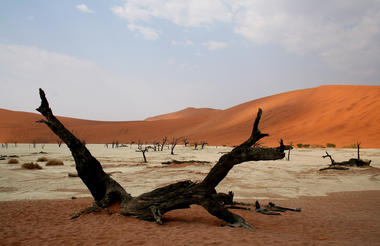
Situated in southwestern Namibia at the edge of the world-renowned Namib Desert, the Tiras Mountains provide the perfect backdrop for visitors who venture to this red granite wonderland and immerse themselves in the natural beauty of this region. Namibian landscapes are synonymous with tranquility, serenity and endless open spaces and the magnificent Tiras Mountains encapsulate this quiet charm. Nature lovers flock here for an off-the-beaten-track experience in one of Namibia's most beautiful areas. Visitors can enjoy thrilling 4X4 mountain and dune tours, nature walks, game and bird viewing as well as excursions through quiver tree forests and to ancient rock paintings on granite rocks. Visitors can relax at one of the luxurious farm lodges after a wonderful day of activities, or get up close with nature while camping in this beautiful desert wilderness.



Prepare to be dazzled by the Fish River Canyon, a colossal masterpiece sculpted by time and nature in Namibia’s far south. Stretching an awe-inspiring 160 km in length, 27 km in width, and plunging up to 550 meters deep, it is Africa’s largest canyon — and the second-largest in the world. Its vast, rugged beauty captures the imagination of adventurers and dreamers alike.
For those who long to connect more deeply with this ancient landscape, Fish River Lodge offers a truly unique experience on the western rim of the canyon. Perched dramatically on the edge, the lodge provides exclusive access to guided walking trails that meander along the rim and descend into the canyon’s depths. Led by experienced local guides, these hikes reveal dramatic rock formations, weathered cliffs, ancient quiver trees, and the quiet signs of desert wildlife. Whether you prefer a gentle sunrise walk along the rim or a more challenging descent into the canyon, each trail offers a soulful, unforgettable connection to this geological wonder.
Those in search of serenity can simply relax at the lodge and take in the endless views from the rim, or explore the area on guided nature drives that reveal the canyon’s fascinating geology and sparse but resilient life.
Whether you come for adventure or reflection, the Fish River Canyon promises a journey through time — and a destination of epic natural beauty.
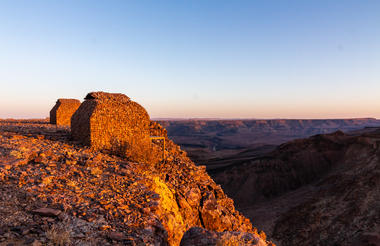
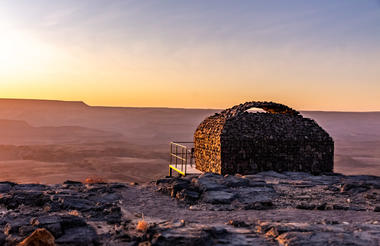
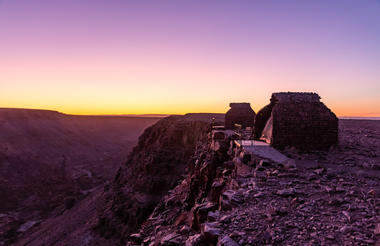
Fish River Lodge - Malerische Sundowner-Fahrt
Fish River Lodge - Canyon-Fahrt
Fish River Lodge - Canyon-Wanderung
Fish River Canyon Canyon Drive (Full day)AM Scenic Drive
Canyon Rim Walks Canyon Sundowner DriveFat bike trials
Set amidst the arid terrain near Keetmanshoop are the ancient quiver trees, a striking Southern African phenomenon with twisted branches reaching towards the sky. These tall and photo-friendly trees, reaching up to eight metres, exhibit a unique dichotomous branching pattern, creating a distinctive candelabra-like silhouette. Slow-growing, some specimens in the forest are estimated to be 200-300 years old, thriving in the harsh climate by storing water in their thick trunks and fleshy leaves. Protected as a national monument in Namibia, the Quiver Tree Forest holds both ecological and cultural significance, with its smooth grey bark and fibrous wood once used by the San people for quivers. Nearby, the Giant's Playground, a geological wonder of large dolerite boulders, boasts a unique feature of appearing haphazardly stacked, as if by a giant child. A nearby rest camp provides a comfortable base for travellers keen to experience Namibia's surreal natural landscapes firsthand.



Spreading across Botswana, South Africa and Namibia, the Kalahari meaning 'the great thirst' is an exceptionally beautiful living desert. The landscape is characterised by a large semi-arid sandy savannah draped over a gently rolling inland sea of sand covering most of Botswana and large parts of Namibia and South Africa. It is also the last bastion of the indigenous San people with the modern world having enveloped all the other areas they once roamed. The Namibian portion is made up of red sands covered in thin, wispy, mostly golden grass and dotted with acacia trees and wide-ranging wildlife including gemsbok, impala, jackals and cheetah.



Combining the former Kalahari Gemsbok National Park of South Africa and the Gemsbok National Park in Botswana, the enthralling Kgalagadi Transfrontier Park is a wonderland of bright orange dunes, spectacular wildlife and fascinating flora. This hauntingly beautiful desert land is part of Africa’s first transfrontier park, ensuring that conservation is the top priority for this vast ecosystem and its inhabitants - it also supports and protects the indigenous people here, the ‡Khomani San and Mier communities. Visitors can look forward to spotting lions, leopards, hyenas, cheetahs, blue wildebeest, springbok, eland, and more than 200 bird species, including migrating flamingos and pelicans, and numerous raptors. Some of the activities on offer include game drives, 4x4 excursions, hiking, swimming, eco trails, star-spotting and nature photography.



As previously described



The pretty, underrated farm town of Kakamas rests on the banks of the Orange River in the Northern Cape, near the border with Namibia and just south-west of Upington. Boasting gorgeous natural springs, excellent wine tasting opportunities and a private game reserve, the town is a little-known destination with much to offer. Visitors can relax in the stunning, turquoise The Riemvasmaak Hot Springs which have been converted into pristine pools set deep in the ravines, surrounded by wild fig trees. Animal lovers can spot leopards and a huge array of brightly coloured birds at the Khamkirri Private Game Reserve, while gourmands can indulge in a range of spectacular flavours at the wine estates and world-class restaurants. Other highlights include: functioning water wheels on the canals, the historic German war graves, and a range of outdoor sports.



Nestled amongst rugged mountains, Springbok is Namaqualand's commercial and cultural centre. This prosperous town has various sites of interest, including historical monuments, museums, a scenic 4x4 route, several excellent mountain biking trails, and some fascinating geology - making for a wonderful photographic trip. Springbok is also close to the beautiful Namaqualand wildflower reserves, the secluded Richtersveld National Park, and the thundering Augrabies Falls. Another great spot to cool off while enjoying nature here is the pretty Port Nolloth Beach, nearby. The town makes for a wonderful stop on the way to Namibia.



Located in the scenic Olifants River Valley, the town of Clanwilliam is the ‘Rooibos Capital of the World’. The town features an array of tea houses and historical buildings. It is conveniently situated next to a large dam perfect for water skiing, swimming, and fishing. Visitors can enjoy a tour at the Elandsberg Rooibos Estate to view the unique tea-making process, learn about the town’s history at the Old Gaol Museum, explore the ‘Rooibos Route’ and enjoy a cup of tea at one of its many stopovers namely, The Rooibos Teahouse. Don’t miss the opportunity to explore the spectacularly scenic surrounds including: the Cederberg Mountains, the West Coast and the annual wildflower splendour of Namaqualand.
History
A BRIEF HISTORY OF CLANWILLIAM
BEGINNINGS
One of the ten oldest towns, Clanwilliam's beginnings goes back to 1660 when a team of Dutch explorers who were sent out by Jan van Riebeeck first reached the Olifants River. When they entered the valley, the saw a large number of elephants on the riverbank. Jan Danckaert, the Dutch cadet in charge of the party, then named the river.
In 1732 the first farm in the Olifants River valley was awarded to Pieter van Zyl. The Town was originally known as Jan Disselsvlei , after Jan Dissel, a local pioneer and a botanist who lived in the Rhenosterbosch at Piquetbergen.
The area first formed part of the district of Stellenbosch, but was declared a sub-district of its own in 1808 by the Earl of Caledon, then Governor of the Cape.
A new name: On 1 January 1814, Caledon's successor, Sir John Cradock, renamed the area after his father-in-law, the Earl of Clanwilliam. It cannot be said with certainty when the town originated, but according to the available information it must have been between 1804 and 1808.
ARRIVAL OF THE 1820 SETTLERS
Lord Charles Somerset (Governor of the Cape Colony from 1814) wanted more people to be sent out to the Cape and to be settled in the Eastern Cape. As a result of his idea of an immigration scheme the British Government decided in July 1819 to go forward with the scheme which for them had a three-fold purpose:
* To populate the eastern frontier of the Cape of Good Hope
* To increase the English-speaking community in their new Colony.
* To ease political tensions in Britain that had been stretched to breaking point with post-war unemployment, industrialisation and poor trade.
On 12 February 1820 the ships "East Indian" and "Fanny" left Cork with four, mainly Irish, groups of immigrants and reached Simons Bay on 30 April and 1 May respectively. From there they sailed to Saldanha Bay. Although Lord Charles Somerset was planning to settle all the settlers in the Zuurveld in the Eastern Cape, the acting Governor, Sir Rufane Donkin, decided to grant land in the vicinity of Clanwilliam to four groups of Irish Settlers to keep them separate from the other Settlers.
The four groups were led by William Parker, Captain Walter Synnot, Captain Thomas Butler and Mnr. John Ingram and consisted of 126 men, 73 women and 159 children. Rev. Francis McCleland, paid by the Colonial Government, accompanied them while Parker was the leader.
Every male immigrant older than eighteen would receive one hundred acres to cultivate and after three years ownership would be transferred to them. The land they would receive was marked out for each group as follows:
Parker: Kleine Valley (1 600 morgen)
Ingram: Groote-en Kleine Patryse Valley (1 350 morgen)
Butler: Taaybosch Kraal (600 morgen)
Synnot: The present farm De Vlei (500 morgen)
When Parker heard that he had to go to Clanwilliam and not Knysna, as he had thought, he continued to cause problems for the authorities and demanded to be settled in Saldanha Bay, but eventually returned to Ireland in 1822.
The rest of the Settlers decided to move to Clanwilliam.
After a short while in Clanwilliam, the Settlers realised that they would not be able to make a living here. The arable land was not enough and the heat necessitated irrigation. Most of them were skilled labourers anyway and even the farmers among them did not understand the South African conditions. They requested a transfer and were taken to the Eastern Cape where they settled.
However, Ingram remained and he was able to buy the land of those who left at a very low price. Also Synnot remained and on 30 November 1821 he was appointed the assistant magistrate of the area.
When, in 1825, Rev. McCleland had only six families left in his congregation he was transferred to Port Elizabeth. The small group who settled here permanently included surnames like Foster, Freyer, Shaw, McMahon, and others. Even though they were a small group, they played a leading role in the area until the first half of the previous century.
GROWTH AND DEVELOPMENT OF CHURCH AND CONGREGATION
Until 1826 Clanwilliam formed part of the town Tulbagh, although a portion of the population chose to attend Zwartlandkerk (Malmesbury).
For more than eighty years Roodezand and Zwartland remain the nearest churches. It should be mentioned that the priest of Tulbagh did visit Clanwilliam once a year for the sacraments and serving the baptism.
Marquard was born in 1789 in Pruise and settled in the Netherlands at the age of 18 where he finished his theological course. After that he was sent to the "Cape of Good Hope" to work with the coloured people of the Clanwilliam district. In 1815 he travelled from Europe and settled in Clanwilliam.
When his fellowship decided to place his mission work under the control of the London Missionary Society in 1816, Marquard was so dissatisfied, that he left their service and joined the "Colonial Reformed Church". He became a member of the Zwartland Church but stayed in Clanwilliam as an independent missionary.
DEVELOPMENT IN THE AREA
In 1914 the Bulshoekdam was built in the Olifantsriver, about fifteen miles north of Clanwilliam, to bring irrigation to Vredendal. In 1935 the Clanwilliam dam was completed. On August 15, 1935 the dam overflowed for the first time.
In June 1958 the national road (N7) between Citrusdal and Clanwilliam finally opened and in 1963 the one between Clanwilliam and Klawer opened.
DEVELOPMENT IN THE TOWN
Although initially very slow, the town gradually grew into a modern country town with a population of 264 whites and 840 coloureds in 1907 to 818 whites, 1,372 coloureds and 24 blacks, according to the census records of 1960.
In 1901, the town received municipal status with Mr. Charles Fryer, one of the descendants of the 1820 Irish Settlers, as the first mayor.
In 1964 the town received its own coat of arms which symbolized the citrus industry and the Olifants River. The motto "Toujours Pret" (Always Ready) is derived from the coat of arms of the Clanwilliams in Scotland.
This picturesque town, the beauty of the Northwest, has had its own hydroelectric generator since 1938 which provided electricity for the most part of the year. In 1958 it was enlarged at a cost of R 80 000. Also the town's water supply scheme was improved in the same year for an amount of R42 000.
A modern Memorial Library was built during 1958 for the amount of R20 000. It was named after Dr. C. Leipoldt, who spent his childhood years here, and his friend, Dr. P. le Fras Nortier, the father of the seedless orange tree.



In 1488, Portuguese explore Bartolomeu Dias became the first European to sail around the southern tip of Africa. The Portuguese dubbed it Cabo da Boa Esperanca, or Cape of Good hope. During the 17th century, the Dutch and English challenged the Portuguese for control of the sea routes around Africa to India and beyond, and the lucrative trade in spices. In 1652, the Dutch East India Company established a permanent base at Table Bay on the Cape of Good Hope where ships could replenish their supplies. Under Jan van Riebeeck, the Dutch began thoe colonization of South Africa.
Set at the confluence of the Indian and Atlantic oceans and backed by the iconic Table Mountain, the bustling city of Cape Town presents an alluring combination of drawcards. Incredible powdery white beaches, highly acclaimed wine routes, and astonishingly beautiful mountain trails surround a cosmopolitan hub. This diverse metropolis is filled with superb shops and restaurants, extraordinary heritage monuments, a multitude of entertainment venues, and a spectacular, chic waterfront harbour. Highlights include the Zeitz Museum of Contemporary African Art; Table Mountain's jaw-dropping views; Boulders Beach, where penguins might swim right up to you in the warm Indian ocean waters; the Kirstenbosch Botanical Gardens, where you can walk along a treetop canopy among incredible native flora or watch an open-air concert at the base of the mountain; Robben Island, where visitors can see the cell where Nelson Mandela was imprisoned for 18 years; and many more.
